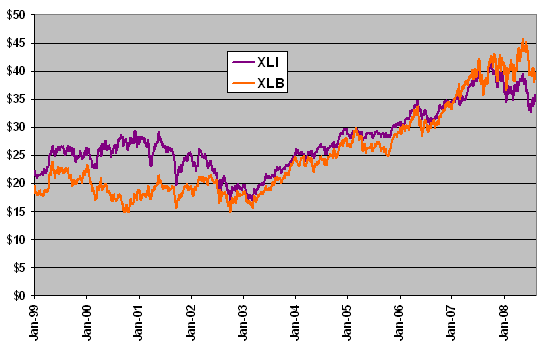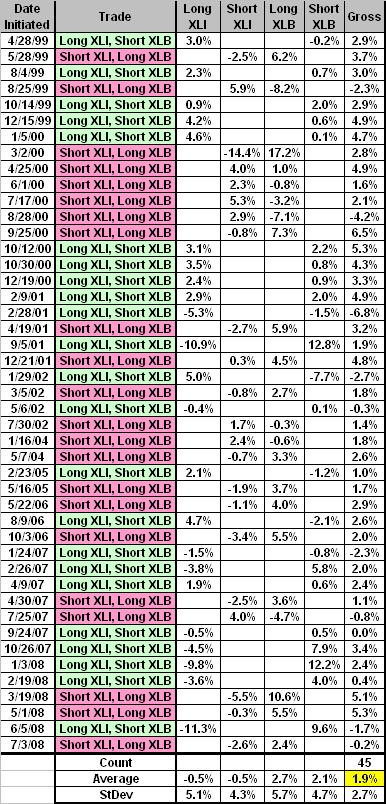Do short-term relative mispricings of equity sectors offer a means to capture abnormal returns? To investigate, we measure the returns from trading potential “errors” in the relative price movements of a pair of sector exchange-traded funds (ETF) selected from the following:
Materials Select Sector SPDR (XLB)
Energy Select Sector SPDR (XLE)
Financial Select Sector SPDR (XLF)
Industrial Select Sector SPDR (XLI)
Technology Select Sector SPDR (XLK)
Consumer Staples Select Sector SPDR (XLP)
Utilities Select Sector SPDR (XLU)
Health Care Select Sector SPDR (XLV)
Consumer Discretionary Select SPDR (XLY)
Using daily adjusted closing prices (incorporating dividends) for these ETFs during 12/22/98-8/15/08, we find that:
As a first step, we look for ETF pairs that have historically moved together. The following table shows the daily return tracking errors for all possible pairs among the nine ETFs over the entire sample period, with the lowest tracking errors highlighted in yellow. Although not quite the lowest, we select XLB and XLI for pair trading because it seems logical that materials demand (XLB) would mirror industrial activity (XLI).
![]()
The following chart shows the price trajectories of XLB and XLI since the beginning of 1999. It confirms that the two ETFs have often, but not always, tracked closely. It appears that tracking may break down during economic recessions or slowdowns.

Next, we set rules for identifying short-term mismatches in the prices of XLB and XLI, as follows:
- For a short-term baseline, we use the average difference in XLB and XLI prices over the past 21 trading days (one calendar month). Daily deviations from this average difference may indicate a temporary relative pricing “error.” Since the prices of XLB and XLI are generally close, we do not bother to normalize them.
- As a threshold of statistical significance, we look for daily mismatches of at least two standard deviations of the price variation over the past 21 trading days. Daily fluctuations this dramatic could indicate imminent reversion of the XLB-XLI relationship.
- As a threshold of economic significance, we require also daily XLB-XLI price differences that are at least $1.00 different from the average price difference over the past 21 trading days.
- Whenever the XLB-XLI price mismatch breaches the statistical and economic thresholds, we go long the undervalued ETF and short the overvalued ETF at the daily close in equal dollar amounts using all available capital.
- When the XLB-XLI price difference returns to its (moving) 21-trading day average, we exit these positions at the close.
These rules generate 95 pair trading signals over 9+ years. Some of the signals are clustered, such that the all-available-capital assumption allows only the 45 trades listed in the following table. Trade durations range from a few days to a few weeks. The average gross (before trading friction) return per trade is +1.9%. Assuming a total trading friction of roughly 1% for each pair of two-way trades, the average net return per trade is +0.9%. About three quarters of trades are profitable on this net basis. The average gross return for all 95 trading signals is 2.1%. Note that:
- There are about five trades per year on average, such that there is no trade active perhaps 80% of the time. There are no trades in 2003 and only two trades in each of 2004 and 2005. A standalone pairs trading strategy appears to require a large inventory of pairs at all times in order to keep capital largely engaged in trades.
- For this pair of ETFs, only the XLB side of the trade is profitable on average, but 2007-2008 trades drive the unprofitability of the XLI side. Both the long and the short sides of the XLB trades are profitable on average.
- Average gross profitability of trades declines somewhat from 1999-2002 to 2003-2008 (2.2% to 1.6%).

In summary, this simple sector ETF pair trading strategy offers modest average abnormal returns, but only infrequent trading opportunities. A standalone pairs trading strategy of any kind probably requires a large inventory of potential pairs.
Different pair selection methods, different mismatch identification rules and different rule thresholds may produce substantially different results. For example, one might select pairs based on tracking error over a floating window of historical data (say, one year) rather than over a long period. One might base trade exits on profit and loss thresholds rather than a reversion rule. However, the more strategy variations tested, the greater the risk of being fooled by data mining bias.